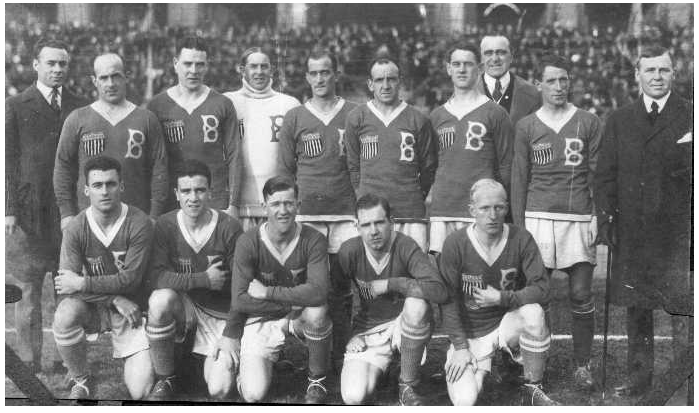
Overseas tours by American soccer teams have become, while not commonplace, at least not as unusual as they once were. MLS teams regularly take preseason training tours in warm climes like Spain and Portugal. The New York Cosmos made many preseason tours in Latin America and postseason ones in Europe or Asia. And in 1968, the Dallas Tornado infamously made a 45-game tour of 19 foreign countries before they’d ever set foot in Texas.
The grand-daddy of them all, however, is Bethlehem Steel. In the summer of 1919, the Pennsylvania team became the first American soccer club ever to make an overseas tour when it played 14 games in Sweden and Denmark. The destination of the tour reflected the fact that it was a familiar route. The U.S. national team had made a Scandinavian tour in 1916.
Bethlehem Steel was the best team produced by American soccer in the first quarter of the 20th century (maybe the first three-quarters), and 1919 was its best year. It easily won the National Association Foot Ball League title that year, finishing with 19 points in the standings and an eight-point margin over second place. It won both the National Challenge Cup and the American Football Association Cup, beating the same team, Paterson FC, in both finals.
For the Scandinavian tour, it got even better. Eleven of Bethlehem’s regular players made the tour, Whitey Fleming, Harry Ratican, Tom Murray, Bill Duncan, Fred Pepper, Jimmy Wilson, Jock Ferguson, Jim Campbell, George McKelvey, William Forrest and Sam Fletcher. They were supplemented by six guest players. Four of the guests, Albert Blakey, George Tintle, Rabbit Heminsley and James Robertson, had been members of the U.S. national team that toured Scandinavia in 1916. The other two, Archie Stark and Davey Brown, were the stars of Paterson FC.
The team was run by Thomas W. Cahill, the secretary of the U.S. Football Association, who served as manager; Billy Sheridan, manager of Bethlehem’s athletic programs, who served as trainer, and Ernest Viberg, a New York soccer official, who served as interpreter and business manager. This was Cahill’s second time leading an American team to Scandinavia. The fact that he had been manager of the national team on its 1916 tour was a factor in why he was chosen this time even though he had no official connection with Bethlehem Steel. His duties were similar to what is now performed by the general manager of a pro sports team. The job of coaching the team on the field was performed more by trainer Sheridan, although the line of demarcation between the two jobs was a bit vague.
Today, traveling soccer teams fly across the Atlantic in a few hours. In 1919, the Bethlehem team’s ship left New York on July 23 and docked in Goteborg 12 days later. The tour began in Stockholm on Aug. 10 against Allmanna Idrottsklubben, popularly known then and now as AIK. The game, a 2-2 tie, seems to have been disappointing to the Swedish fans, not because their team failed to win, but because they viewed Bethlehem Steel more as a Scottish team than an American one, and expected more from it. Bethlehem Steel finished the tour on Sept. 24 with a record of seven victories, two defeats and five ties. The games drew a total of 154,000 spectators, including 23,000 for the opener in Stockholm, the largest crowd Bethlehem had ever played in front of.
Probably Bethlehem’s best game of the tour was a 4-0 victory on Aug. 27 over an all-star team from Skane, the southernmost province of Sweden. The Bethlehem lineup in that game included six future Hall of Famers, goalkeeper Tintle, defender Ferguson, and forwards Stark, Brown, Ratican and Fleming. Despite the presence of four superstar forwards on the roster, the leading scorer for the tour was Heminsley with eight goals.
The 1919 trip to Scandinavia was Bethlehem Steel’s only overseas tour, although it nearly made another a year later. A proposed Brazilian tour was cancelled by the Brazilian government at the last minute on Aug. 14, 1920, as the team was preparing to board its ship in New York for the voyage to South America.
A version of this post originally appeared on Roger’s Big Soccer blog on May 22, 2011.
